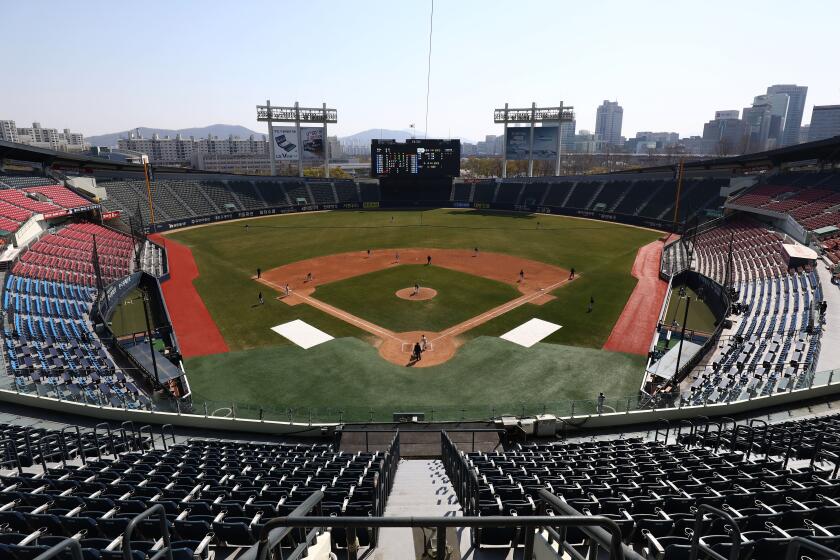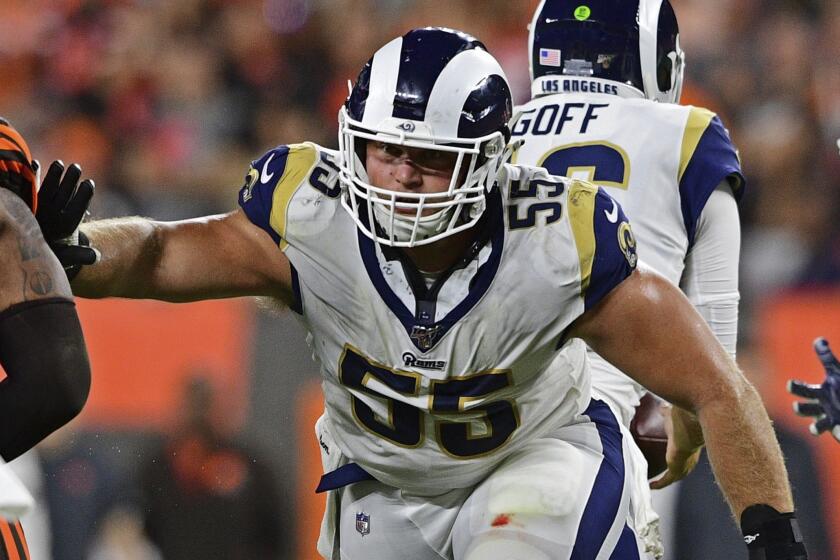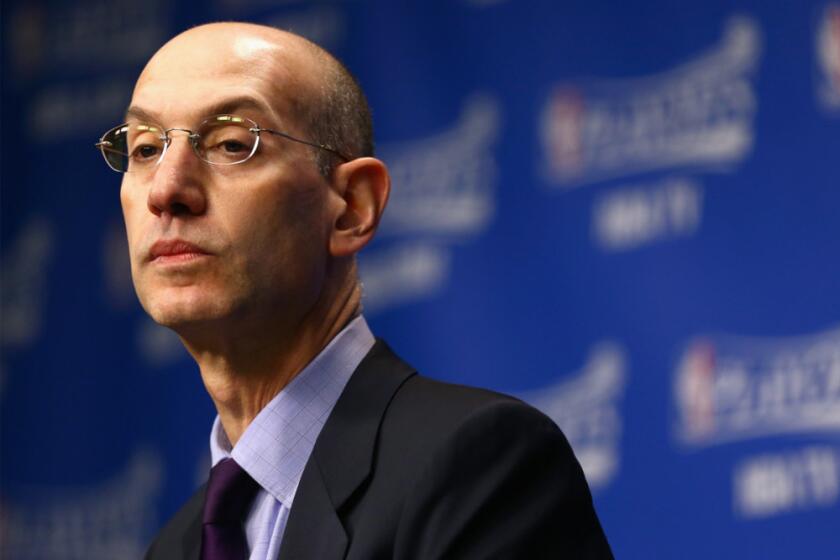Hundreds of workers shelter in stables at Santa Anita, trying to survive racing ban
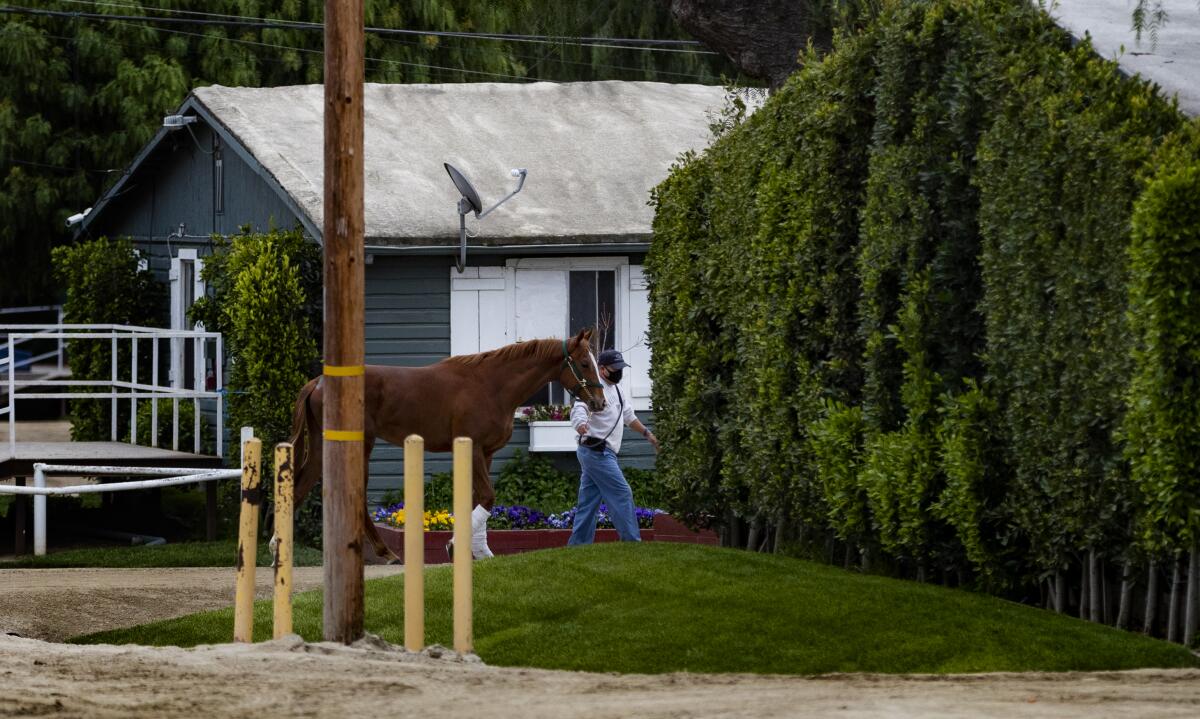
- Share via
Peacocks wail from a nearby arboretum, the sound ringing through a parking lot along the backstretch of Santa Anita Park racetrack. On a crisp Saturday morning, there are more than 200 cars, most of them belonging to those who bathe, brush, walk, exercise and train the hundreds of horses in the stables.
Inside is a community that includes more than 700 people who, as part of their compensation, live in small dorm-style rooms set in well-worn buildings near the barns, and others who commute to the track each day. The workers, many of them immigrants from Mexico and Central America, still have jobs because facilities that care for animals are considered essential and therefore exempt from stay-at-home-orders that have closed many Los Angeles County businesses during the COVID-19 pandemic.
But their futures are tenuous. On March 27, county health officials ordered Santa Anita to stop holding races, effectively amputating the industry’s financial arm.
A look at how sports leagues, including the NFL, MLB, MLS, NBA and NHL, are responding to the coronavirus outbreak.
Santa Anita made a proposal to the county commissioner and public health officials last week, seeking to restart live racing. The decision to shut down “was based on the definition of what constitutes an essential business,” the Los Angeles County Department of Public Health said in an email. Some people in the business wonder whether there wasn’t a different reason.
Activists lobbied hard last year to rein in the sport as 30 thoroughbreds died after racing or training at the track. Sen. Dianne Feinstein and Gov. Gavin Newsom were publicly critical and at times called for a halt to the races. This season, 11 horses have died at the track, including two after racing stopped.
County health officials did not answer an email asking whether pressure from animal rights groups had an impact on last month’s decision to close down racing.
Oscar de la Torre, a labor organizer who engages with workers on the backstretch, believes animal rights activists seized on the current climate to try to shut down the track. “It’s pretty obvious that’s what they intend to do,” he said.
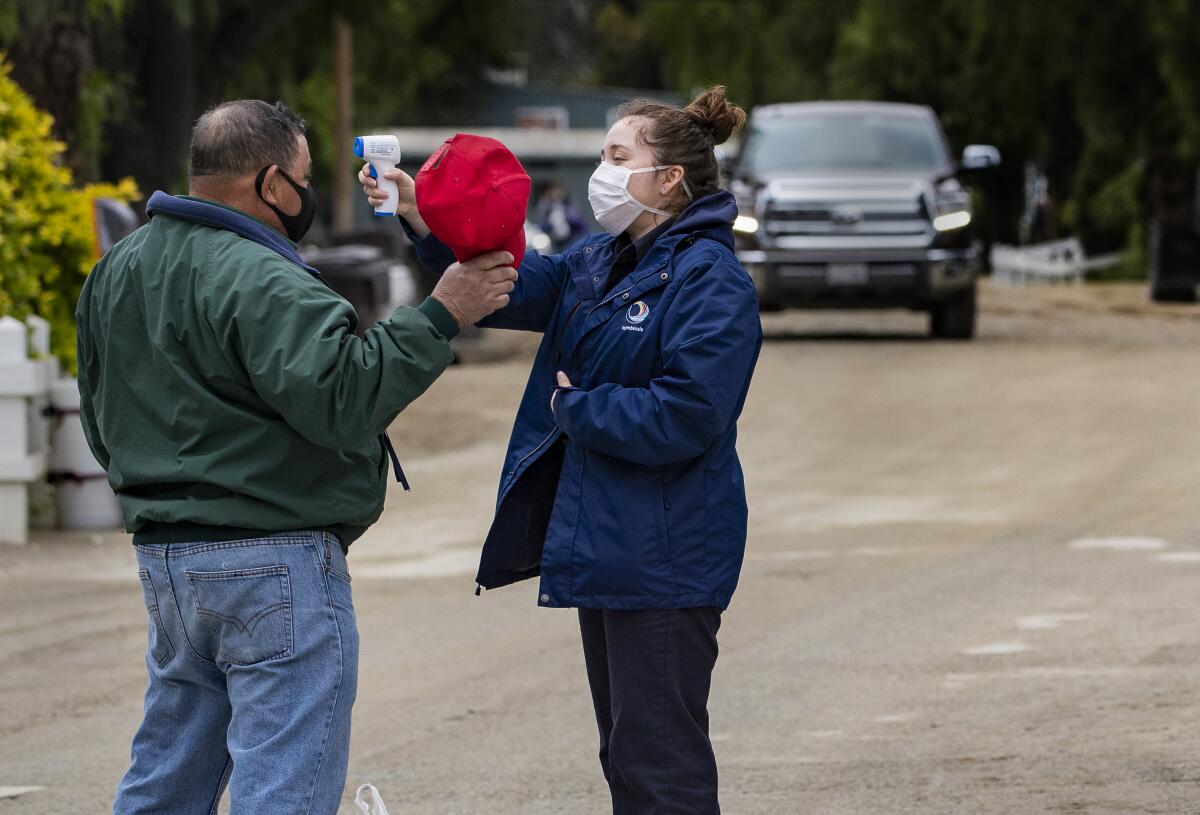
Weeks before authorities stepped in, Santa Anita had closed the track to fans and anyone not deemed indispensable to the races. Halting the competition choked off the last vestige of revenue. On the last day of racing, off-track bettors wagered more than $7 million. There were nine races with purses totaling $431,000.
The potential for big paydays keeps many owners involved in racing, because for the vast majority the sport is a financial drain. Trainers on average are paid $100 to $125 a day to train a horse, win or lose. Ten percent of winnings generally go to the trainer and the money trickles down from there.
“When a horse wins, they give us, maybe, 1%, and that’s extra money we earn to help the family,” said Dagoberto Lopez, who has spent 35 years working as a groom at Santa Anita.
Lopez immigrated from Querendaro, in the Mexican state of Michoacan, where most people farm and raise animals. He and his wife live in South Gate with their three sons, two of whom work at the track during summers when they don’t have school.
“My mom worries,” said Jayro Lopez, Dagoberto’s oldest son. “… She keeps bringing up, ‘What if someone actually gets the disease, what are we going to do?’ She says if that does happen, she doesn’t want my dad commuting there, but also how are we going to sustain the bills?”
A look at athletes, coaches and others in the sports world who have tested positive of the coronavirus.
Caring for or training horses is the only business most backstretch workers know. For those who live there, the prospect of losing their jobs is compounded by the fear of losing their homes.
“I’d be homeless, on the street,” said Ruthie Barrera, a stable worker who lives at the track.
It’s a concern shared by many of her colleagues, but one the track hopes to assuage. “Unless the track was told to close completely, no one will be asked to leave,” said Aidan Butler, chief executive of California racing for the Stronach Group, which owns Santa Anita.
Barrera makes $15 an hour — better than most, she said, because of her 22 years of service. She grew up on a ranch in Guatemala where she learned to love horses.
Some trainers compensate workers by the number of horses they care for, and the shrinking population at the track means a smaller paycheck. That’s been a problem throughout the industry and hit Santa Anita hard last year when the high rate of horse deaths caused the track to lose dozens of racing dates. Track officials were hoping for a rebound this year, but the pandemic exacerbated the situation.

Miguel Contreras, a groom, said the barn he works for has not lost many, but “from the other barns there’s a lot of horses. Every day we see horses leaving.”
Trainer Steve Martinez estimated there were still nearly 2,000 horses stabled at Santa Anita “that have to be bathed, fed, vetted, shoed, walked, taken to the track and galloped.” But now with no money coming in. “Why do they have to take away the only way we have to support the people,” he asked, “but they don’t mind having them working?”
The job starts each morning around 4:30, before the sun rises to reveal the majestic San Gabriel Mountains to the north. Fifteen to 20 people work in each of the 64 barns along the backstretch. The horses are combed and bathed, then led along muddy dirt roads marked with hoof and boot prints between each barn. There are 30 to 40 stables in each barn, some with goats to calm the horses. The workers care for them, too.
NBA Commissioner Adam Silver said there are still too many factors regarding the COVID-19 pandemic to consider when or if to resume the season.
There is a medical center on the premises, but it doesn’t test for COVID-19. Some workers with symptoms were tested at outside facilities, and their tests returned negative. Still, there is concern.
“Some of the people at the racetrack, they’re afraid about things going on right now. So am I,” said Adan Fuentes, 59, an exercise rider who lives in Azusa. “I just go to the track, do my job and go home every single day. I don’t want to get the disease and then give the disease to another person.”
Fuentes grew up in Jalisco, Mexico, and has been working at Santa Anita since in 1988. Lately, he’s seen the number of people around him dwindle. Jockeys no longer are allowed on the backstretch, and neither are horse owners or some vendors who used to visit. But there are still people around each barn, and Fuentes tries to steer clear, interacting only with the horses.
Before the pandemic, people who lived away from the track simply had to show their licenses to enter. Now they also have their temperatures taken and must confirm they have a mask to wear. Not everybody wears one inside, but many do. Fewer wear protective gloves.
After the horse are attended to, some workers head home while the residents might make a run to a store, or hit the communal bathrooms and showers. Those, they say, are now cleaned more frequently.
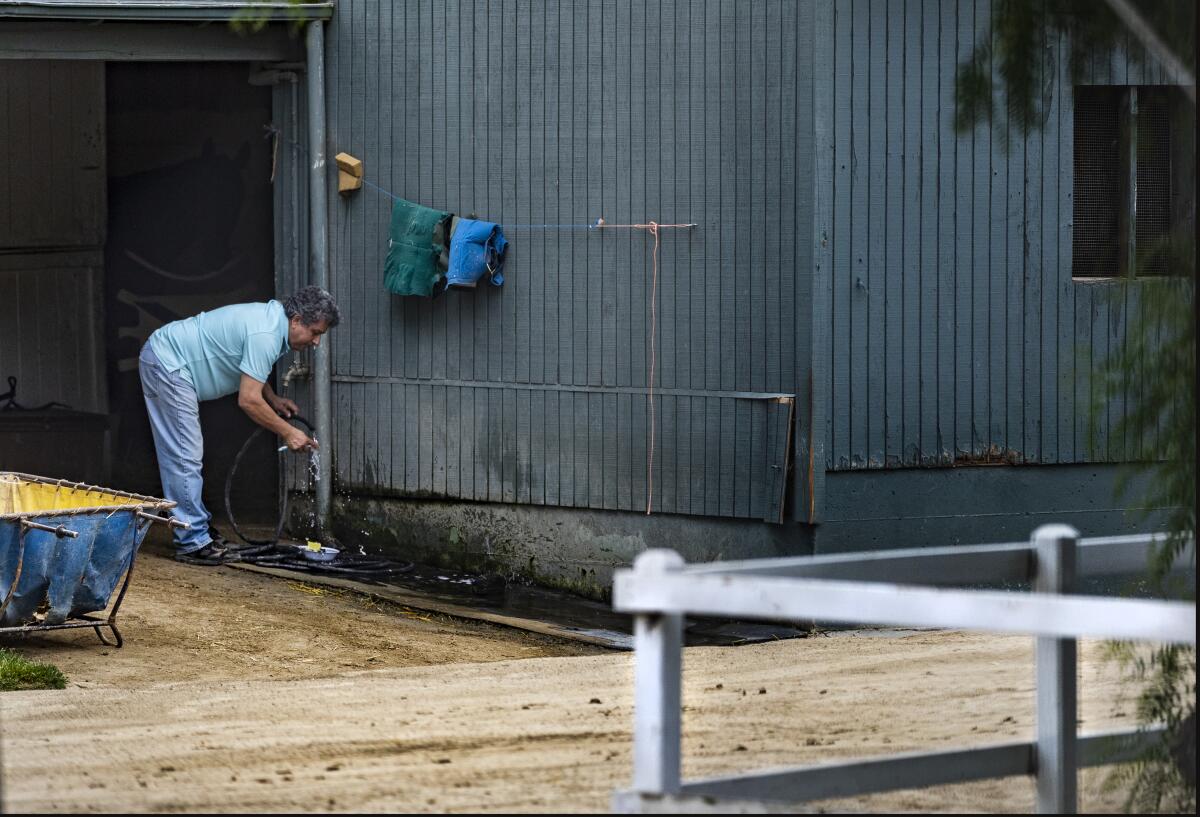
“This is like a little community, a little town inside. A little world,” Contreras said. “… My worry is the people that leave outside the tracks, that go in and out every day. We haven’t had no cases here, but I know for a fact as soon as one or two comes up, there’s a big chance they’re going to shut us down.”
Santa Anita officials have proposed an even more isolated environment around the main track if authorities would allow racing to resume. The most recent plan involves secluded, at-track housing for jockeys. They would be kept away from the group working in the stables.
“This isn’t just, ‘Hey we want to race,’” Butler said. “This is the only way we’re not going to make the situation exponentially worse.”
As those efforts are made, workers along the backstretch toil, and hope.
“… If the virus gets here,” Contreras said, “and — let’s hope not — everybody gets sick, who’s going to take care of the horses?”
Times staff writer Jorge Castillo contributed to this report.
More to Read
Go beyond the scoreboard
Get the latest on L.A.'s teams in the daily Sports Report newsletter.
You may occasionally receive promotional content from the Los Angeles Times.
